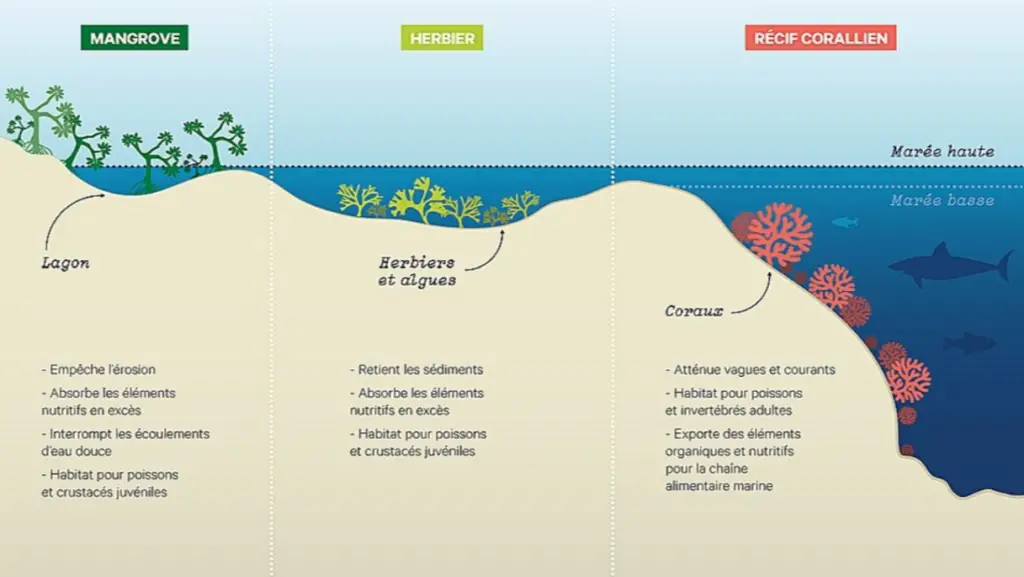Mangroves, seagrass beds and coral reefs are marine ecosystems that are interconnected and play a crucial role in the health of our oceans and our planet. These habitats are home to a great deal of biodiversity and are also essential ecosystems, from coastal protection to carbon capture. It is more important than ever to highlight their interdependence and contribution to the balance of life in the context of climate change and environmental degradation.
Entangled Ecosystems : The Vital Synergy between Mangroves, Seagrass Beds and Coral Reefs
Mangroves, seagrass beds and coral reefs form an interconnected network. Mangroves and seagrass beds reduce sedimentation and pollution that could otherwise smother the corals. In turn, coral reefs act as a protective barrier against waves, creating the calm conditions necessary for mangroves and seagrass beds.
Recently, international initiatives have focused on restoring these ecosystems. Programmes such as The Coral Planters aim to rehabilitate damaged reefs. In addition, research indicates that the joint restoration of these habitats could strengthen their resilience in the face of climate change and improve biodiversity as a whole.

Mangroves: the Guardians of the coasts

Mangroves, which are found in tropical and subtropical areas, cover approximately 137,760 km² of land. They play a vital role in protecting coastlines from erosion and storms, and act as nurseries for many marine species, which makes them an invaluable natural resource. Up to 80 different species can be found there. Mangrove roots filter sediments and pollutants, thereby enhancing the quality of coastal waters.
In 2020, the FAO (United Nations Food and Agriculture Organisation) reported that 67% of the world’s mangroves were intact.
On average, 0.13% of mangroves are lost each year.
This has significant implications for biodiversity, as well as for the human communities that rely on these ecosystems for their livelihoods.
Mangroves provide invaluable support to coastal communities, offering essential natural resources and safeguarding their homes from natural disasters.
Mangroves contribute to the food security of coastal and marine communities by supporting productive and diverse fisheries.
Mangroves are a popular location for scientific research and environmental education programmes.
Sea grass beds: the lungs of the oceans
10% of the ocean’s carbon is sequestered by these ecosystems, although they cover only 0.1% of the seabed.
300,000km² of the ocean’s surface is covered by seagrass beds.These seagrass meadows are often called the ‘lungs of the oceans’ because of their ability to produce oxygen and absorb carbon dioxide. They serve as feeding and breeding grounds for many marine species, including important commercial fish.
Seagrass beds are threatened by a number of anthropogenic and natural factors. Pollution, coastal urbanisation, ocean acidification, sea level rise and climate change are all pressures that are degrading these vital ecosystems. The destruction of seagrass beds leads to a loss of biodiversity and reduces the ability of the oceans to sequester carbon.

Coral reefs: the jewels under threat

0.1% of the seabed is covered by coral reefs
25% of marine life is found in coralsThey protect coastlines by reducing wave energy. Reefs are also essential to local economies, particularly tourism and fishing. Unfortunately, coral reefs are among the ecosystems most vulnerable to climate change.
75% of the world’s reefs have been affected by ocean bleaching caused by warming waters.
If current trends continue, more than 90% of reefs could be seriously degraded by 2050.Protecting and conserving coral reefs is therefore essential to maintaining the health of the oceans and marine biodiversity, as well as supporting the human communities that depend on them.
Mangroves, seagrass beds and coral reefs are essential to the health of the oceans and the survival of many species, including humans. Their good health is crucial to ensuring that marine life thrives and can withstand the effects of climate change. It is imperative that conservation efforts are strengthened and supported by robust international policies to ensure a sustainable future for these precious ecosystems.




